FIRST DAY COVER – A cover created by a government or privately created for the issuance of a postal item (Stamp, Postal Card, Stamped Envelope, or Aerogramme.
SPECIAL COVER – A cover created by the government for a special event.
SPECIAL POSTMARK – A special cancellation only.
FIRST DAY COVERS
First Day Covers (FDCs) are created for the issuance of a postage stamp, whether it is a single stamp, a set, or a souvenir sheet. The cancellation reflects the date the stamp was officially issued. In Bangladesh the cancellation is made available for several days or so, and during that period anyone can either buy the officially printed envelope that is sold by the Post Office, or provide their own envelope. Because the Post Office has prepared envelopes for the issuance of most of the stamps, there has been surprisingly few privately printed First Day Cover cachets made. Because the Post Office generally did/does not make envelopes for most definitive and SERVICE overprinted stamps, collectors have made a few cachets, or simply cancelled the stamps on plain envelopes. The SERVICE overprinted stamps are no longer made and used by the government but when in use were used for official government mail only and not sold to the public. That would explain why there are so few SERVICE overprinted FDCs. In Bangladesh there are no companies that produce envelopes for FDCs, nor offer a subscription service.
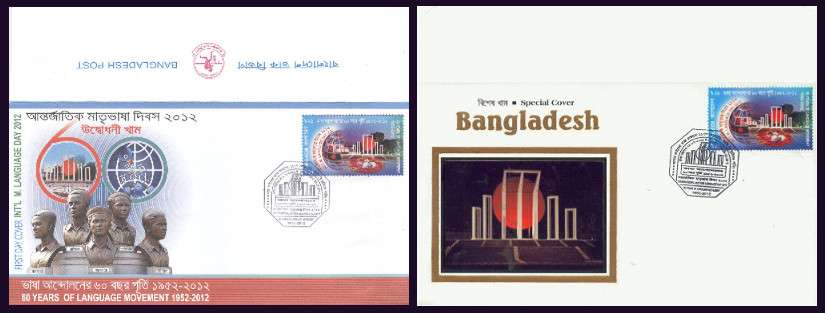
On the left is an official FDC produced by the Bangladesh Post Office Department. The cachets are printed at the Postal Printing Press by the government. Most, but not all, officially produced FDCs will have the Bangladesh P.O. logo printed on the back. After a few years the Post Office added a line or two of text on the back of the envelope. For years there was little consistancy on what was written and where. On the right is a privately produced FDC for the same stamp. It does not have the P.O. logo on the back. This important difference makes if fairly easy to distinguish the official Bangladesh P.O. covers. However, the privately produced covers states “Special Cover”, which it should not say, it should say “First Day Cover”. Special Covers are a separate group of covers prepared by the Bangladesh Post Office and are discussed below.
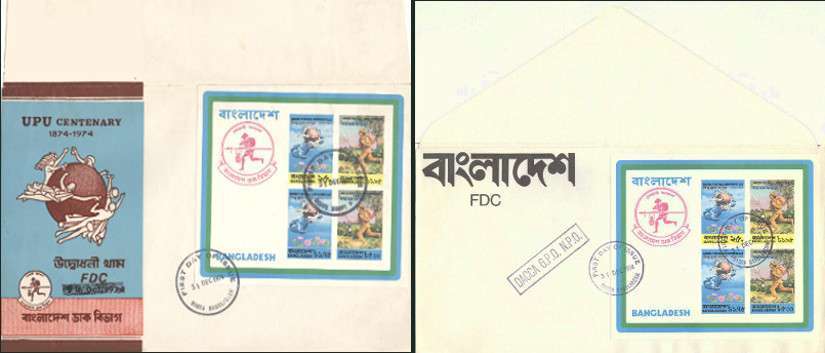
The cover on the left is the official Post Office issued cover for the U.P.U. souvenir sheet. It is one of the few that did not have a logo printed on the back flap of the envelope. There is also no logo on the back of the smaller envelope for the set of the four stamps for the same UPU set. The cover on the right is a privately printed FDC, which also does not have a logo on the back.

To the left is the officially issued FDC with the P.O. logo on the back flap of the envelope. The cover on the right is also the officially issued FDC, but because the gold color was not printed in the cachet, it was not printed on the back of the flap. This is an error in the printing of the cachet. Such errors are found on many of the FDCs issued over the years.
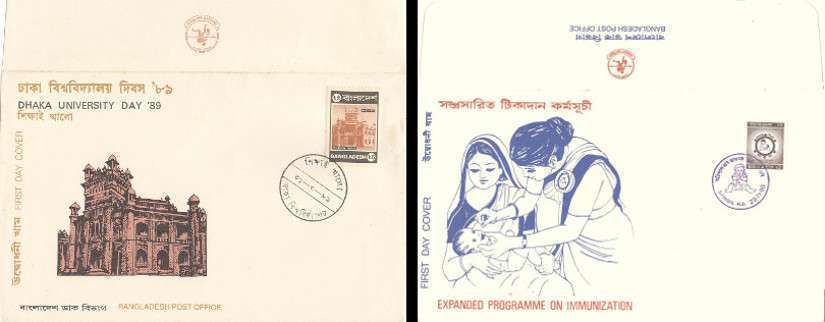
Two of the few Definitive stamps that the Post Office prepared FDCs for, plus a special cancellation on the cover on the right. The cover on the left has a canellation, totally in Bengali. The stamp on the cover was issued the same day as the Special Cover, which had the same subject as the new stamp. Logically, one would use the new stamp on such an envelope.

The above two covers are somewhat of a mystery. Both are official FDC envelopes and cancellations (It is the same cancellation) and both sets of stamps were issued on the same day. The confusion is that the cover on the left is the new Russian printed definitive set. No envelope was printed for this definitive set and most collectors used the larger envelope, of the two. The mystery is why were two different sizes, and designs, printed for the World Communications Year set of three stamps? Perhaps the envelope on the left was the original envelope and they then realized they did not need such a large sized envelope for the three stamps, but that the definitives were going to be released on the same day, and kept the larger envelope for that use. The SERVICE overprinted set of stamps is also found on this larger envelope. It is a very scarce cover as the stamps were not to be sold to the public.
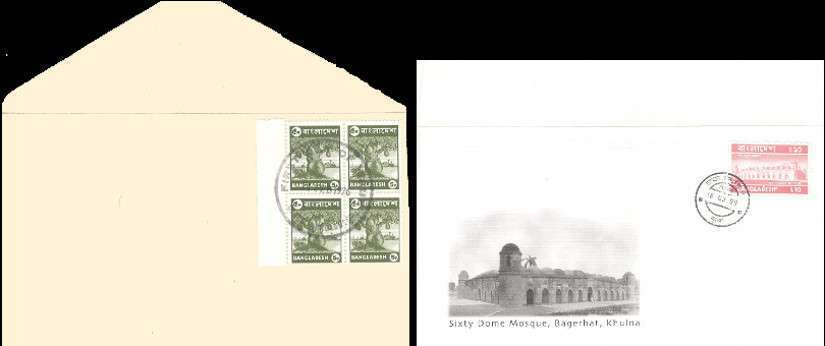
The above two FDCs are for definitive stamps, but the Post Office did not print envelopes for their release. The one has the generic First Day cancellation and the other an ordinary postal cancellation. The cover on the left is on a plain envelope and the one on the right with the cachet is a privately printed envelope. Such quality privately printed FDCs are scarce.
FIRST DAY COVERS
Special covers, like First Day Covers, are made and sold by the Post Ofice. A special cancellation is also made for the event. The envelopes are sold at the Post Office and the cancellor is made available for a period of time, just like the FDCs. While FDCs are for the issuance of a stamp, Special Covers are for specific events that can be for one or more days. Where the event lasts more than one day, often the Post Office provides a different envelope and/or cancelor for each day. Each of these envelopes are printed by the Post Office and each has the logo on the back flap. The trend today, if the event lasts more than a few days, is to only make one envelope with a different cancellation for each day. In some instances the only thing that changes is the cancellation date, others can be totally different designs. The problem has been that people call just about any cover, i.e. stamp issuance or otherwise, a Special Cover. Even the Post Office at times uses the term improperly.
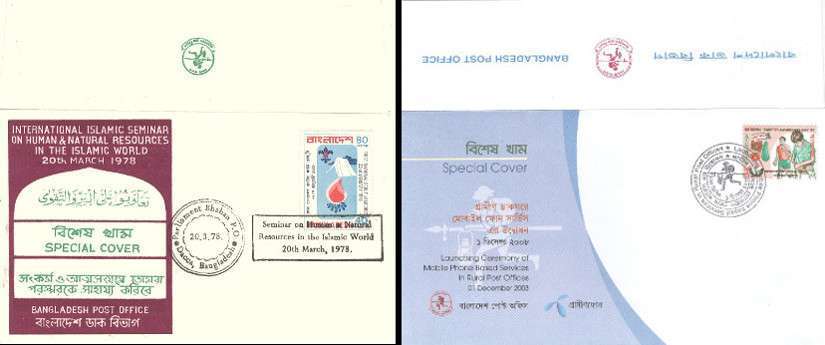
The two covers above are Special Covers for which the Post Office provided a printed envelope and a special cancellation for the event. Both covers correctly have, “SPECIAL COVER” printed on it. At times, collectors will apply stamps that are related to the subject of the event, and that can make the cover appear a little nicer. The cover on the left is for the International Islamic Seminar on Human & Natural Resources in the Islamic World that was held on the 20th of March 1978. The cover on the right is for the Launching Ceremony of Mobile Phone Based Services in Rural Post Offices on 1 December 2008. Note that neither stamp has anything to do with the subject but what the collector wants is the envelope and the cancellation.

The two Special Covers above have an added bonus – the stamps are related to the subject. While this is not needed in collecting Special Covers, it is always nice that they have stamps on them that reflect the subject. The cover on the left is for World Health day 1988 and the stamp was issued a year earlier. The cover on the right is for the 1st National Voluntary Blood Donation & Posthumous Eye Donation Day, 1995. The stamp was issued in 1991. First Day Covers exist for both of these stamps.
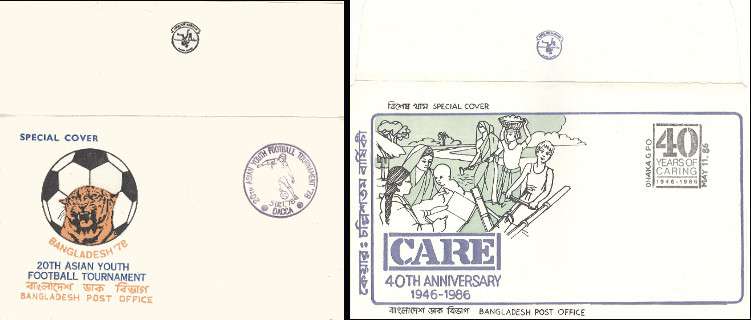
A peculiar aspect of collecting Special Covers is that often you will find the envelopes with no stamps on them, but they do have the cancellation. They make the entire cancellation much easier to see, but such covers are not considered as desirable as ones with the stamps. When making a FDC one must have the stamps on the envelope, as that is the reason the envelope and cancellation exist. Because there is no stamp involved with Special Covers, collectors often just cancelled the blank covers.
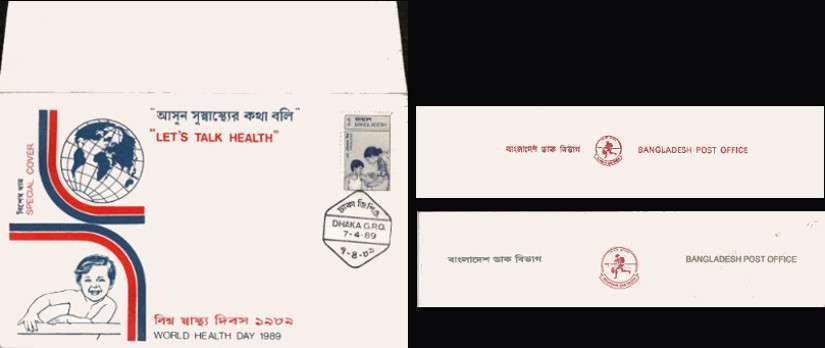
The Special Cover above is unique in that it was printed without the logo and sold out rapidly. The cover was reprinted again with the small red logo and sold out. It was reprinted a third time with the larger logo and the text in blue on either side of it. The scarcest one is the smaller logo.
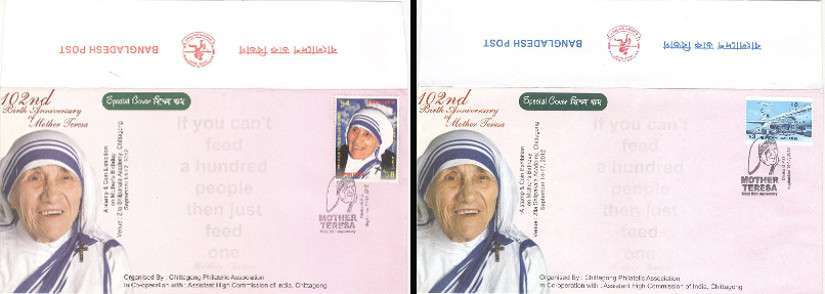
The Special Cover envelope with the red logo and text on the back for the Mother Teresa celebration sold out almost immediately. The envelope was reprinted, due to demand, and for the second printing they changed the text on either side of the logo to blue. The first printing (All in red) is the scarcer of the two. Notice how much nicer the cover with the Mother Teresa stamp on it is.
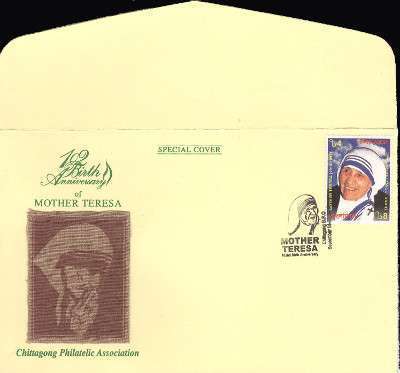
A privately created cachet for the Mother Teresa ceremony. In this instance only the official cancellation was obtained. There are very few privately produced Special Covers as it is the government printed envelop/cachet that one wants with the cancellation.

A Special Cover for PABEX ’90 (Philatelic Association of Bangladesh Exhibition 1990). One envelope was created, but three different cancellations, one for each day of the exhibit.
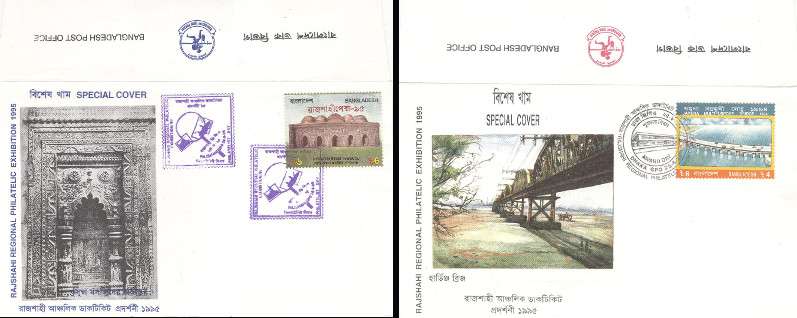
A rare situatuion where the Rajshahi Regional Philatelic Exhibition 1995, that lasted two days, had two totally different envelopes and two different cancellations.

Even the Post Office got these two wrong. Each states First Day Cover (or FDC), but they are both Special Covers. No stamp was issued for these events and the stamps on the covers have nothing to do with the event. Even the cancellations are for First Day Covers. In spite of all this, they are genuine Special Covers.
SPECIAL POSTMARKS
In addition to First Day Covers and Special Covers, the Post office has created Commemorative Cancellations (Special Postmarks). In these instances they only create a cancellor, no cacheted envelopes. In order to obtain the cancellation, one must have one’s own envelope. For this reason, one finds these cancellations on every type of envelope imaginable – everything from postal stationary to plain envelopes. Unfortunately, some collectors did not make wise decisions and the covers are difficult to fit into a collection due to their odd sizes and colors. In a few instances collectors have created envelopes with cachets. Since they are privately made, none have the Post Office logo on the back flap. Unfortunately, this area of collecting has been largely ignored and most collectors have no idea what cancellations exist. No definitive list has yet been made available to collectors, and such may not even exist, however, this catalog is attempting to do so.
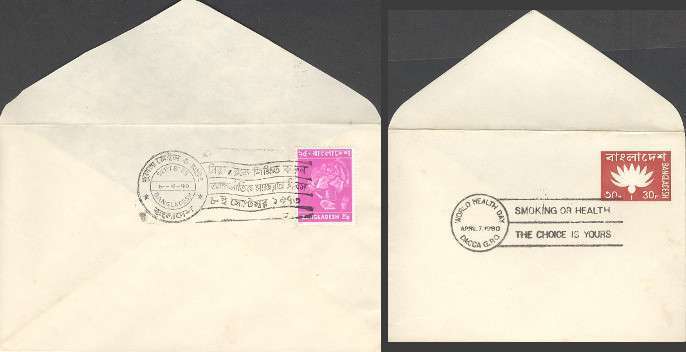
The above Special Postmarks have been applied to a regular envelope and a government printed envelope. Note that the government envelope does not have the logo printed on the back flap. None of the postal stationary items sold to the public have the logo on them. The one on the left is for International Literacy Day and is in Bangla. The one on the right is for anti-smoking and states, “Smoking or Health/The Choice is Yours”.
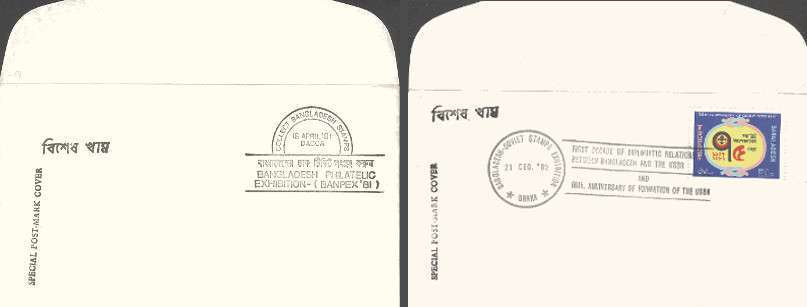
The cover on the left was made without a postage stamp as the person just wanted a copy of the cancellation. This was one of three different cancellations made for BANPEX ’81. The cover on the right has the Special Postmark for two events: First decade of Diplomatic Relations Between Bangladesh and the USSR; And 60th Anniversary of Formatin of the USSR. In both instances the person used a a generic cachet they probably made themselves. It reads, “Special Post-Mark Cover”.

Two covers with the 1997 6th Asia Cup Cricket 97 with the Special Postmark. The one on the left is on a government issued piece of stationary and the one on the right is a very attractive privately produced printed envelope.

The cover on the left was designed by Al-Arefin Khan.
Two privately produced cachets for the World Post Day Cancellation of 2002.

The cover on the left was designed by Ziad Husain and the cover on the right by Eqbal Majid. (Two privately produced cachets for the 3rd SAARC Cricket Tournament 1977).
All of the covers illustrated below are privatly printed cachets for the Special Postmarks.
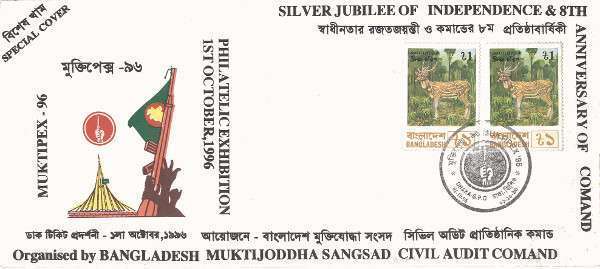

The Anniversary of the Postage Stamp cover was designed by Ahsan Habib.
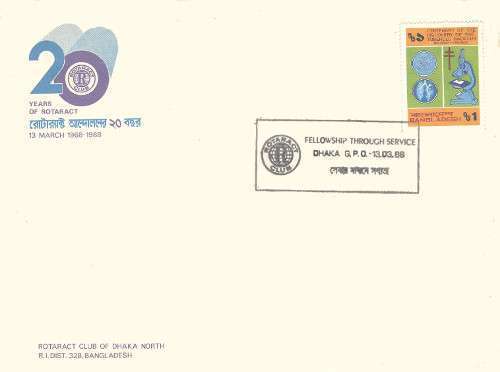

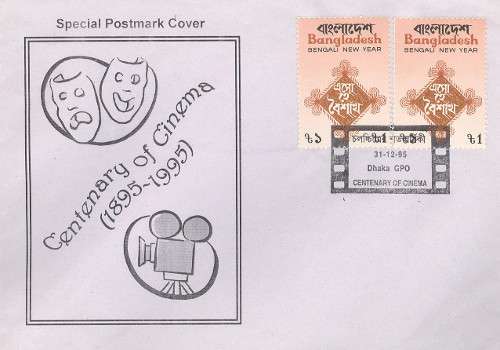
The Cinema cover was designed by Al-Arefin Khan.


The above cover is attractive because of the tie-in of the cachet, stamp and cancellation – all tigers. However, the cover serves no real purpose, other than to use a cacheted envelope that was prepared for a different event, but had not been used. The envelope was originally prepared for the stamp exhibiton in Washington, D.C. from 27 May – 3 June 2006. It has these dates and the logo for the show on the cover, but it was used to obtain the tiger cancellation from the China World Stamp Exhibition, 2009, which was used on 11 April 2009. Such covers have little, or no value as the cancellation is common. It would be better to have it on a plain envelope, rather than a wrong one. The back of the cover has information on the cover that is important and interesting. The layout is somewhat like that on government FDCs and Special Covers. The designer is Dr.Redwan al-Karin Bhuiyan, also known as Dr. Heart. He put his logo of a heart with “HSC”, which stands for Heart Stamp Center. It also has the number 12, indicating that twelve envelopes were printed.


